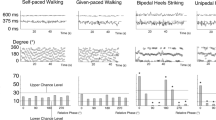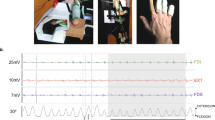Abstract
Using 12 healthy male subjects, the dynamic motor ability of individual fingers was investigated under four different finger tapping conditions. These were: maximum speed tapping with one finger (single-finger tapping), alternate movement of two fingers (double-finger tapping), double-finger tapping in an unsupported condition, and submaximum constant speed tapping with one finger in a passive manner. Key-contact forces for all fingers and the movement velocity of the tapping finger were monitored. With the exception of the unsupported condition, non-tapping fingers were maintained in contact with designated keys during the tapping tasks. It was found that the index finger attained the fastest cadence and greatest movement velocity, followed by the middle, little and ring fingers, respectively. Subjective assessment of rank order of "difficulty" of tapping by the subjects was highly correlated with tapping cadence. Thus dynamic motor function, as indicated by rapid, repetitive movement, differs among the individual fingers. Parallel changes were observed in the key-contact force of the neighboring non-tapping fingers during tapping. The range of the non-tapping finger forces was largest during tapping by the ring finger. A similar trend was found for passive tapping, during which the magnitude of key-contact force was less than one-third of that observed during active tapping. The lower cadence achieved by the ring finger may be attributed more to a lack of independence at the level of voluntary neuromuscular control, than to innate mechanical interaction with the other fingers. Tapping cadence of each finger was lower for the double-finger mode than for the single-finger mode. The magnitude of the observed decrease in cadence during double-finger tapping was, on the other hand, strongly dependent on finger-combination. The decrease was smallest for the index-middle finger-combination, and greatest for the ring-little finger-combination. Compatibilities with other fingers can play an essential role in the dynamic motor function of individual fingers. During the unsupported task, in which interactions were diminished by allowing all fingers to move freely, tapping cadence increased markedly. Therefore, the lower cadences observed in specific finger-combinations may be partly attributed to anatomical and neural interdigit interactions.







Similar content being viewed by others
References
Aoki T, Kinoshita H (2001) Temporal and force characteristics of fast double-finger, single-finger and hand tapping. Ergonomics 44:1368–1383
Aoki T, Kinoshita H (2002) Difference in dynamic motor function of individual fingers and effects of long-term training. In: Kawamura J (ed) Biomechanisms, vol 16. Univ Tokyo Press, Tokyo, pp 143–154 (in Japanese with English abstract)
Barnes WJ, Allison JD (1978) Isometric torque of the finger extensors at the metacarpophalangeal joints. Phys Ther 58:42–45
Donoghue JP, Hess G, Sanes JN (1996) Substrates and mechanisms for learning in motor cortex. In: Bloedel JR, Ebner TJ, Wise SP (eds) The acquisition of motor behavior in vertebrates. MIT Press, Cambridge, MA, pp 363–386
Erdler M, Windischberger C, Lanzenberger R, Edward V, Gartus A, Deecke L, Beisteiner R (2001) Dissociation of supplementary motor area and primary motor cortex in human subjects when comparing index and little finger movements with functional magnetic resonance imaging. Neurosci Lett 313:5–8
Fahrer M (1981) Interdependent and independent actions of the fingers. In: Tubiana R (eds) The hand. Saunders, Philadelphia, pp 399–403
Hager-Ross C, Schieber MH (2000) Quantifying the independence of human finger movements: comparisons of digits, hands, and movement frequencies. J Neurosci 20:8542–8550
Jancke L, Shah NJ, Peters M (2000) Cortical activations in primary and secondary motor areas for complex bimanual movements in professional pianists. Brain Res Cogn Brain Res 10:177–183
Kamakura N, Matsuo M, Ishii H, Mitsuboshi F, Miura Y (1980) Patterns of static prehension in normal hands. Am J Occup Ther 34:437–445
Keen DA, Woodring SF, Schieber MH, Fuglevand AJ (1998) Mechanical coupling of extensor digitorum communis motor units across digits of the human hand. Society for Neuroscience 24:2110 Abstract
Kinoshita H, Murase T, Bandou T (1996) Grip posture and forces during holding cylindrical objects with circular grips. Ergonomics 39:1163–1176
Lieber RL, Jacobson MD, Fazeli BM, Abrams RA, Botte MJ (1992) Architecture of selected muscles of the arm and forearm: anatomy and implications for tendon transfer. J Hand Surg 17:787–798
McKiernan BJ, Marcario JK, Karrer JH, Cheney PD (1998) Corticomotoneuronal postspike effects in shoulder, elbow, wrist, digit, and intrinsic hand muscles during a reach and prehension task. J Neurophysiol 80:1961–1980
Oldfield RC (1971) The assessment and analysis of handedness: the Edinburgh inventory. Neuropsychologia 9:97–113
Radwin RG, Oh S, Jensen TR, Webster JG (1992) External finger forces in submaximal five-finger static pinch prehension. Ergonomics 35:275–288
Sacks RD, Roy RR (1982) Architecture of the hind limb muscles of cats: functional significance. J Morphol 173:185–195
Schieber MH, Gardinier J, Liu J (2001) Tension distribution to the five digits of the hand by neuromuscular compartments in the macaque flexor digitorum profundus. J Neurosci 21:2150–2158
Swanson AB, Matev IB, de Groot G (1970) The strength of the hand. Bull Prosthet Res 10:145–153
Uematsu S, Lesser R, Fisher RS, Gordon B, Hara K, Krauss GL, Vining EP, Webber RW (1992) Motor and sensory cortex in humans: topography studied with chronic subdural stimulation. Neurosurgery 31:59–71
Ungerleider LG, Doyon J, Karni A (2002) Imaging brain plasticity during motor skill learning. Neurobiol Learn Mem 78:553–564
Van Cutsem M, Duchateau J, Hainaut K (1998) Changes in single motor unit behaviour contribute to the increase in contraction speed after dynamic training in humans. J Physiol 513:295–305
Von Schroeder HP, Botte MJ (1993) The functional significance of the long extensors and juncturae tendinum in finger extension. J Hand Surg 18:641–647
Zatsiorsky VM, Li ZM, Latash ML (1998) Coordinated force production in multi-finger tasks: finger interaction and neural network modeling. Biol Cybern 79:139–150
Zatsiorsky VM, Li ZM, Latash ML (2000) Enslaving effects in multi-finger force production. Exp Brain Res 131:187–195
Author information
Authors and Affiliations
Corresponding author
Rights and permissions
About this article
Cite this article
Aoki, T., Francis, P.R. & Kinoshita, H. Differences in the abilities of individual fingers during the performance of fast, repetitive tapping movements. Exp Brain Res 152, 270–280 (2003). https://doi.org/10.1007/s00221-003-1552-z
Received:
Accepted:
Published:
Issue Date:
DOI: https://doi.org/10.1007/s00221-003-1552-z




